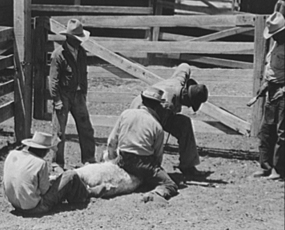 |
 | |
  | |
|
|
|
|
Big Bend National Park
Branded
|
|
|
|
|
|
 |
 |
| Library of Congress #LC-USF33--012190-M3 | | Cattle branding in West Texas, 1939. |
 |
Cattle Brands of the Big Bend, 1944
Cattle ranching came to the Big Bend in the mid-1880s. In the free range era, ownership of livestock was generally established by a brand placed on the animal. After the branding iron turned red-hot, the rancher pressed the seal-like marker against the hide of the cow. The unique mark meant that the cow could then graze freely among other cattle on the free-range of the American West. Drovers could then separate the cattle at round-up time for driving to market. These customs of the American West evolved from the practices of the vaqueros.
Registered brands and their owners—ranchers using parts of the park area, Federal and non-Federal lands, for grazing purposes on July 1, 1944—are reproduced below. Landowners whose property was purchased for park purposes by the State of Texas in 1942 were granted three years of grazing rights and use. The brands vididly represent a cross-section of the unique personalities of the Big Bend and herald the end of a way of life here that had lasted for over fifty years.
|
|

|
 |
|
|
|
|
|
 |
|
Did You Know?
Near the mouth of Green Gulch the road passes the eastern end of the Pulliam Peak intrusion. Here erosion has sculptured the intrusion; from certain places, the mountain profile takes the shape of a man's face that is looking skyward. The mountain profile is locally known as Alsate's Face.
more...
|
|
|
|
Last Updated: September 09, 2007 at 14:31 EST |






